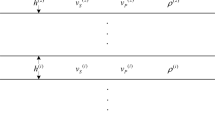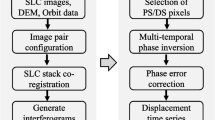Abstract
Multibeam bathymetric system (MBS) has been widely applied in marine exploration activities for providing high-precision seafloor topography. However, the representative error of sound velocity profile (SVP) can degrade the precision of sounding and lead to the distortion of seafloor topography. To resolve this problem, we propose a seafloor topography distortion correction method based on the SVP inversion. It firstly decomposes the SVP using the empirical orthogonal function (EOF), which converts the SVP inversion process into the time coefficient optimization process. The time coefficient is then optimized by the simulated annealing algorithm (SA) based on a cost function, which is constructed by the sounding consistency of the corresponding beams in the overlap** areas of adjacent swaths. Finally, the inverted SVP is calculated by the optimal time coefficient, and then the distortion of seafloor topography can be corrected by the inverted SVP. Experiments conducted on three types of seafloor topography demonstrate that the root mean square values of sounding errors of the proposed method are 39.44%, 34.49% and 62.32% lower than the method based on reconstructed SVP in flat, inclined, and undulating topographies, respectively. Compared with the method based on replaced SVP, these calculated by the proposed method are reduced by 88.38%, 88.08% and 92.82%, respectively. These results suggest that the proposed method can significantly improve the precision of multibeam sounding, and efficiently correct the distortion of the various seafloor topographies.


















Similar content being viewed by others
References
Hellequin L, Boucher JM, Lurton X (2003) Processing of high-frequency multibeam echo sounder data for seafloor characterization. IEEE J Ocean Eng 28(1):78–89
Gaida TC, Mohammadloo TH, Snellen M et al (2020) Map** the seabed and shallow subsurface with multi-frequency multibeam echosounders. Remote Sens 12(1):52
Amiri-Simkooei A, Snellen M, Simons DG (2009) Riverbed sediment classification using multibeam echo-sounder backscatter data. J Acoust Soc Am 126(4):1724–1738
Imren C, Le Pichon X, Rangin C et al (2001) The North Anatolian Fault within the Sea of Marmara: a new interpretation based on multi-channel seismic and multibeam bathymetry data. Earth Planet Sci Lett 186(2):143–158
Tonchia H, Bisquay H (1996) The effect of sound velocity on wide swath multibeam system data. In: OCEANS 96 MTS/IEEE Conference Proceedings, Fort Lauderdale, FL, USA, 1996, pp 969–974
Yang F, Bu X, Ma Y et al (2017) Geometric calibration of multibeam bathymetric data using an improved sound velocity model and laser tie points for BoMMS. Ocean Eng 145:230–236
Jiabiao Li (1999) Multibeam sounding principles survey technologies and data processing methods. Ocean Press, Bei**g
Jianhu Z, **gnan L (2008) Multibeam sounding and image data processing. Wuhan University Press, Wuhan
Wang X, Feng C, Yu J et al (2020) Ways to correct the errors in posture of multibeam sounding resulted from water flow. Mater Sci Eng 780(3):032047
Xu W, Zhang M, Zhang H, et al (2012) Sparse-increment iteration-based sound velocity profile estimation with multibeam bathymetry systems. In: 2012 Oceans, Hampton Roads, VA, USA, 2012, pp 1–5
Linbang He, Jianhu Z, Hongmei Z et al (2015) A precise multibeam sound ray tracking method taking into account the attitude angle. J Harbin Eng Univ 36(01):46–50
Dinn D F, Loncarevic B D, Costello G (1995) The effect of sound velocity errors on multibeam sonar depth precision. In: Challenges of Our Changing Global Environment, San Diego, CA, USA, 1995, pp 1001–1010
Bosheng L, Jiayu L (2010) Hydroacoustics principle. Harbin Engineering University Press, Harbin
Yang F, Li J, Ziyin Wu et al (2008) The methods of high quality post-processing for shallow multibeam data. Acta Geod Cartogr Sin 4:444–450
Jianhu Z (2012) Modern marine surveying and charting. Wuhan University Press, Wuhan
Etter PC (2013) Underwater acoustic modeling and simulation (4th version). CRC Press
Zhiwei Z, **gyang B, Fumin X et al (2018) Inversion of sound velocity profile in multibeam survey based on simulated annealing algorithm. Geomat Inf Sci Wuhan Univ 43(8):1234–1241
Qingliang D, Minxun C, Junhua Z et al (2011) Analysis and processing of transform geography of convex and cave in multibeam sounding system. Hydrogr Surv Chart 31(1):32–35
Snellen M, Siemes K, Simons DG (2009) A model-based method for reducing the sound speed induced errors in multibeam echo-sounder bathymetric measurements. In: OCEANS 2009-EUROPE, Bremen, Germany, pp 1–7
Zhao J, Yan J, Zhang H et al (2014) A new method for weakening the combined effect of residual errors on multibeam bathymetric data. Mar Geophys Res 35(4):379–394
Sun W, Bao J, Liu M et al (2016) Sound velocity profile (SVP) inversion through correcting the terrain distortion. Int Hydrogr Rev 13:7–16
C. Didier, E. Jaouad, G. Gaspard, et al (2019) Real-time correction of sound refraction errors in bathymetric measurements using multiswath multibeam echosounder. In: OCEANS 2019—Marseille, Marseille, France, 2019, pp 1–7
Mohammadloo TH, Snellen M, Renoud W et al (2019) Correcting multibeam echosounder bathymetric measurements for errors induced by inaccurate water column sound speeds. IEEE Access 7:122052–122068
Yuanbi X, Zhencan P, **gyang B et al (2020) Sounding velocity integrated error correction method of multibeam data based on Kalman filtering. Geomat Inf Sci Wuhan Univ 45(9):146–153
Chen C, Ma Y, Liu Y (2018) Reconstructing Sound speed profiles worldwide with Sea surface data. Appl Ocean Res 77:26–33
Yangfan L, Zhenjie W, Shuang Z (2020) Layered-EOFs based adaptive reconstruction of sound velocity profile in multibeam sounding. Tech Acoust 39(3):372–378
Mafarja MM, Mirjalili S (2017) Hybrid whale optimization algorithm with simulated annealing for feature selection. Neurocomputing 260:302–312
Han X, Dong Y, Yue L et al (2019) State transition simulated annealing algorithm for discrete-continuous optimization problems. IEEE Access 7(44):391–403
Chadwell CD, Sweeney AD (2010) Acoustic ray-trace equations for seafloor geodesy. Mar Geod 33(2):164–186
** Lu, Shaofeng B, Motao H et al (2012) An improved method for calculation average sound speed in constant gradient sound ray tracking technology. Geomat Inf Sci Wuhan Univ 37(5):590–593
Yang HQ, He QR, Qi S et al (2012) Method of sound ray refraction correction for underwater target location. J Henan Normal Univ 40:36–39
Ben-Ameur W (2004) Computing the initial temperature of simulated annealing. Comput Optim Appl 29(3):369–385
Triki E, Collette Y, Siarry P (2005) A theoretical study on the behavior of simulated annealing leading to a new cooling schedule. Eur J Oper Res 166(1):77–92
Cohn H, Fielding M (1999) Simulated annealing: searching for an optimal temperature schedule. SIAM J Optim 9(3):779–802
Zhiwei Z, **gyang B, Jianju L (2017) Order selection of EOF expression of sound velocity profile in multibeam surveys. Hydrogr Surv Chart 5:20–24
Fengying W (2007) Modern climate statistics diagnosis and prediction technology (2nd version). Meteorological Press, Bei**g
Xu H, **ao Z, Chen K et al (2019) Spatial and temporal distribution, chemical characteristics, and sources of ambient particulate matter in the Bei**g-Tian**-Hebei region. Sci Total Environ 658:280–293
Sun W, Bao J, Liu M et al (2016) Inversion of sound velocity profiles by correcting the terrain distortion. Geomat Inf Sci Wuhan Univ 41(3):348–355
Geng X, Zielinski A (1999) Precise multibeam acoustic bathymetry. Mar Geod 22(3):157–167
Acknowledgements
The study is funded by National Key Research and Development Program of China (2020YFB0505800 and 2020YFB0505804), National Natural Science Foundation of China (41931076, 41874032 and 41731069), Open foundation of State Key Laboratory of Geo-information Engineering (SKLGIE2019-Z-2-2).
Author information
Authors and Affiliations
Corresponding author
Additional information
Publisher's Note
Springer Nature remains neutral with regard to jurisdictional claims in published maps and institutional affiliations.
About this article
Cite this article
Liu, Y., Xu, T., Wang, J. et al. Multibeam seafloor topography distortion correction based on SVP inversion. J Mar Sci Technol 27, 467–481 (2022). https://doi.org/10.1007/s00773-021-00845-7
Received:
Accepted:
Published:
Issue Date:
DOI: https://doi.org/10.1007/s00773-021-00845-7




